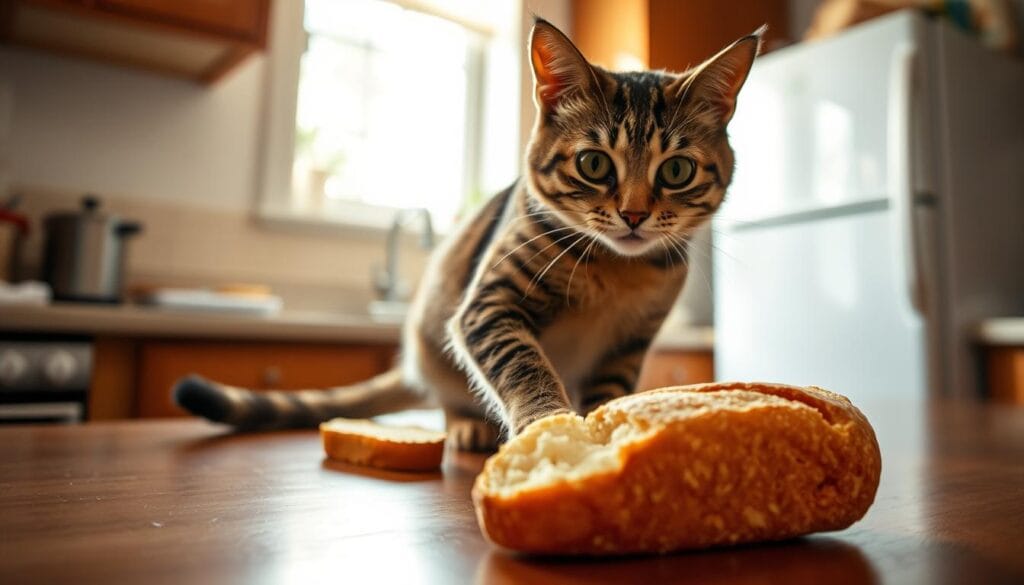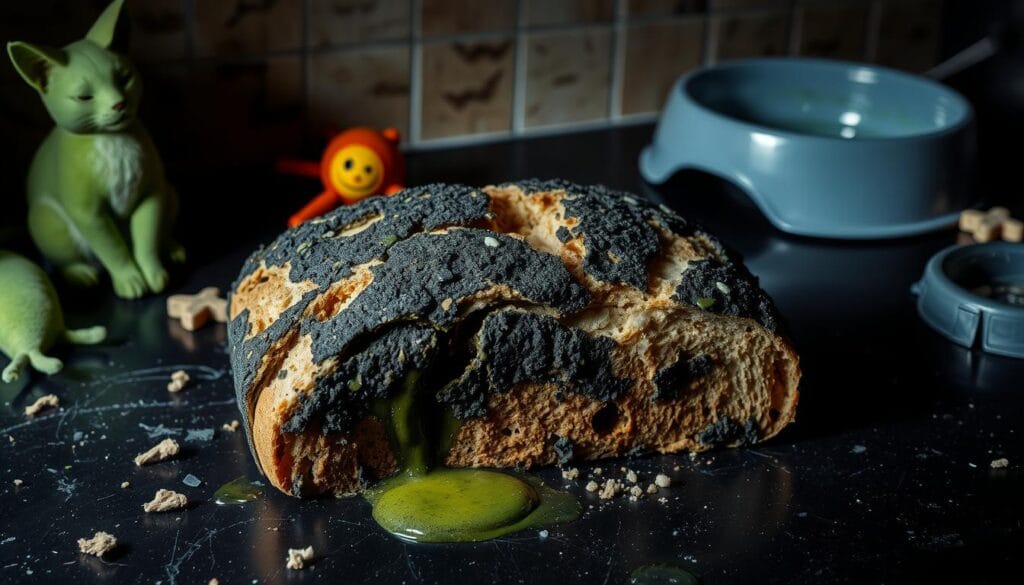Can Cats Eat Bread Safely? Discover Feline Diet Secrets
Can cats eat bread safely ?
Picture your furry companion eyeing your morning toast with quiet curiosity. Many pet owners face this moment, wondering whether sharing a bite aligns with their animal’s well-being. While bread fills our plates, feline biology tells a different story.
Household pets evolved as meat-eaters, relying on protein-rich meals for energy and health. Their bodies lack the enzymes to process carbohydrates efficiently, making most grains filler rather than fuel. A small nibble of plain bread won’t harm them, but it’s like offering candy—tasty yet nutritionally void.
Table of Contents
Regularly feeding carb-heavy snacks risks weight gain or digestive discomfort. Think of it this way: your pet’s system prioritizes animal-based nutrients, not bakery treats. Occasional crumbs might pass unnoticed, but their diet thrives on meat’s amino acids and fats.
This guide unpacks how to balance occasional indulgences with your companion’s biological needs. You’ll learn why moderation matters and how to spot signs of dietary imbalance. Let’s explore what truly fuels their vitality—and where bread fits into that picture.
Introduction: Exploring Bread in Your Cat’s Diet
Behind those pleading eyes lies a digestive system built for meat, not muffins. This guide helps you navigate the intersection between feline biology and human food curiosity, starting with core nutritional truths.
Purpose and Overview of This Ultimate Guide
You’ll discover evidence-based answers about balancing occasional treats with species-specific needs. We clarify myths surrounding grain consumption while establishing practical feeding guidelines. Key priorities include maintaining muscle mass through protein-rich meals and avoiding carb-heavy fillers.
Understanding Your Cat’s Nutritional Needs
Obligate carnivores require diets with 70-80% animal-based protein for optimal health. Compare these biological requirements to typical bread components:
| Nutrient | Feline Needs | Bread (per slice) |
|---|---|---|
| Protein | 30-40% | 2-4g |
| Carbs | <10% | 15-20g |
| Taurine* | Essential | Absent |
*Critical amino acid for heart and vision health. Regular carb intake disrupts metabolic balance, increasing diabetes risks. Your companion thrives when their meals mirror evolutionary adaptations.
Can cats eat bread
While many human foods spark curiosity in pets, bread often raises questions about compatibility with animal biology. Let’s examine key factors influencing safety and dietary value.
General Safety Considerations
Plain baked varieties pose minimal risk in tiny portions. However, ingredients like garlic or raisins—common in specialty loaves—can trigger toxicity. Observe your pet closely after offering even small crumbs, watching for vomiting or lethargy.
Portion control remains critical. A 4kg companion requires roughly 180 daily calories. Just 10g of bread delivers 26 calories—14% of their allowance. Overindulgence displaces protein-rich food essential for muscle maintenance.
Nutritional Implications of Bread for Felines
Grains lack taurine and arachidonic acid—nutrients vital for heart function and skin health. While carbohydrates provide quick energy, felines metabolize them inefficiently. Regular consumption may strain pancreatic function over time.
Consider this comparison for perspective:
- 1 bread crust (5g) = 13 empty calories
- Equivalent meat portion = 3g protein + essential fatty acids
Reserve baked goods for rare occasions, prioritizing species-appropriate meals. Consult your veterinarian if introducing new items to sensitive digestive systems.
Bread as a Treat: When It’s Acceptable

Offering a nibble from your plate requires understanding what’s harmless versus harmful. While some pets show interest in baked goods, their bodies process these items differently than ours. Moderation becomes critical when considering non-essential snacks.
Portion Size and Frequency
Limit bread to thumbnail-sized amounts—roughly 5 grams—once weekly. This equals about 10% of a typical pet’s daily calorie needs. Larger quantities displace protein-rich meals essential for maintaining muscle mass.
Consider these guidelines for safe sharing:
- Use plain varieties without seasonings or additives
- Offer only as medication carriers or rare rewards
- Adjust portions for less active companions
Track weight changes through regular vet checkups. Increased lethargy or digestive issues signal the need to reduce carb intake. Remember: even approved quantities provide zero nutritional value, making meat-based snacks healthier alternatives.
Balance curiosity with biological needs by prioritizing species-appropriate foods. Reserve human snacks for exceptional moments, ensuring they never compromise dietary fundamentals.
Identifying Potential Health Risks
Sharing a snack with your pet might seem harmless, but their body processes ingredients differently than yours. While occasional nibbles may not cause immediate harm, repeated exposure to unsuitable foods can trigger hidden health issues.
Signs of Digestive Discomfort
Watch for vomiting or loose stools within hours of consumption. These symptoms often indicate stomach irritation from unfamiliar ingredients. Other red flags include reduced appetite or unusual lethargy lasting more than 24 hours.
| Symptom Type | Immediate Effects | Long-Term Risks |
|---|---|---|
| Digestive | Diarrhea, abdominal pain | Chronic inflammation |
| Dermatological | Excessive scratching | Skin infections |
| Metabolic | Weight fluctuations | Diabetes development |
Carbohydrate Overload and Its Effects
Frequent carb intake disrupts natural metabolic processes. Over time, this imbalance may lead to obesity or insulin resistance. Grain-sensitive pets might develop skin lesions or persistent ear infections from prolonged exposure.
Always consult your veterinarian if unusual symptoms appear. Early intervention prevents minor health issues from becoming critical concerns. Track reactions carefully—some pets show delayed responses days after ingestion.
Safe Bread Types for Your Cat
Navigating the bakery aisle with your pet’s health in mind requires knowing which options pose minimal risks. Plain white, wheat, or rye varieties often emerge as safer choices due to their simplified ingredient lists. While these types lack nutritional value for felines, they’re less likely to trigger immediate health concerns when offered sparingly.
White and Wheat Bread Insights
Basic white bread tops the safety list because it typically contains only flour, water, yeast, and salt. Wheat versions follow closely if they exclude seeds or sweeteners. Check labels for additives like dough conditioners or artificial flavors—these often hide in seemingly simple loaves.
| Bread Type | Key Ingredients | Safety Notes |
|---|---|---|
| Plain White | Flour, water, yeast | Lowest risk option |
| Whole Wheat | Whole grains, water | Avoid seeded varieties |
| Rye | Rye flour, caraway* | Skip spice-heavy recipes |
*Caraway seeds may cause mild stomach upset in sensitive pets.
Understanding Additives and Plain Varieties
Unseasoned options prove safest. Garlic powder, onion flakes, or xylitol—common in specialty loaves—can damage red blood cells or cause organ failure. Stick to ingredients you recognize from basic recipes.
When sharing, tear off crust-free pieces smaller than a postage stamp. This minimizes carb overload while satisfying curiosity. Always prioritize protein-rich treats over empty calories, even from “safe” bread types.
Breads to Avoid for Feline Health
Your kitchen’s aroma of freshly baked goods might tempt curious noses, but not all loaves belong near whiskered companions. Certain varieties contain ingredients that disrupt biological functions or trigger severe reactions. Knowing which options pose hidden dangers helps protect your pet’s well-being.

Dangerous Additives: Garlic, Banana, and Pumpkin Bread
Seasoned or sweetened loaves often hide toxic components. Garlic bread tops the risk list—its allium compounds destroy red blood cells, risking anemia. Even small licks of butter coatings may cause weakness or breathing difficulties.
| Bread Type | Toxic Ingredients | Health Risks |
|---|---|---|
| Garlic | Allium derivatives | Anemia, organ damage |
| Banana | Cinnamon, nutmeg | Neurological issues |
| Pumpkin | Cloves, excess sugar | Obesity, diabetes |
Banana and pumpkin varieties introduce unnecessary sugars and spices. Nutmeg in these recipes may induce tremors, while cinnamon irritates digestive linings. These additives offer zero nutritional value while threatening metabolic balance.
The Risks of Uncooked Dough and Yeast
Raw bread dough presents dual threats. Active yeast ferments carbohydrates, producing ethanol that poisons the bloodstream. Simultaneously, expanding masses in the stomach may rupture intestinal walls.
Watch for vomiting, disorientation, or abdominal swelling if accidental ingestion occurs. Immediate veterinary care becomes critical—delayed treatment risks coma or fatal bloating. Store baking projects securely, far from adventurous paws.
Decoding Bread Ingredients in Feline Diets
Understanding what’s in your loaf can mean the difference between a harmless treat and a health hazard. Commercial breads often contain additives that range from nutritionally useless to dangerous for animals. Sugar, artificial sweeteners, and flavor enhancers frequently appear on labels—these empty calories may lead to weight gain or digestive issues over time.
| Ingredient | Risks | Safe Alternative |
|---|---|---|
| Garlic/Onion Powder | Blood cell damage | Unseasoned options |
| Xylitol | Liver failure | No-sugar recipes |
| Walnuts/Pecans | Pancreatitis risk | Seed-free varieties |
Grain-based recipes pose separate challenges. Wheat and corn—common in many loaves—are frequent allergens for sensitive pets. Reactions might include skin irritation, ear infections, or chronic itching. Preservatives like calcium propionate can accumulate in systems, potentially disrupting gut health.
Specialty breads with dried fruits or seeds introduce unnecessary fats and salts. Always check labels for hidden spices like nutmeg, which may cause neurological issues. When sharing, choose plain white varieties without dough conditioners or stabilizers.
Your vigilance with ingredient lists protects your companion from hidden dangers. Prioritize simple recipes if offering human food, and consult your vet about suspected allergies. Remember: every crumb counts when safeguarding their well-being.
Monitoring Digestive Reactions After Eating Bread
Observing your pet’s behavior post-snack helps catch issues before they escalate. While most reactions appear within hours, some may develop gradually over days. Immediate attention to changes ensures quick intervention when needed.
Symptoms to Watch For
Mild signs often include stomach gurgling or reduced interest in meals. Loose stools or occasional vomiting might occur if their system struggles with unfamiliar ingredients. Note any unusual lethargy or refusal to engage in playtime—these subtle cues often precede visible distress.
Emergency Indicators and When to Act
Persistent vomiting (more than twice in 24 hours) demands urgent care. Difficulty breathing, seizures, or sudden collapse indicate life-threatening complications from toxic additives. Contact your vet immediately if you notice tremors, excessive drooling, or swollen abdomens.
| Mild Reactions | Critical Emergencies |
|---|---|
| Single vomiting episode | Repeated vomiting/diarrhea |
| Temporary appetite loss | Neurological symptoms |
| Mild bloating | Respiratory distress |
Document the type and quantity consumed—this information helps veterinarians assess risks faster. Time-stamp symptoms to identify patterns, especially if multiple issues arise. Quick action often prevents minor upsets from becoming severe health crises.
Why Some Cats Are Drawn to Bread
Have you ever wondered why your pet paws at your sandwich? Their attraction often stems from instinctual behaviors rather than nutritional needs. Scents and textures play surprising roles in this curious fascination.
The Allure of Aromas and Physical Sensations
Yeast produces compounds that mimic meaty odors to sensitive noses. This biological trick explains why some animals investigate rising dough or fresh loaves. The soft, pliable surface also resembles prey textures, triggering kneading instincts from kittenhood.
While these traits make baked items intriguing, they don’t equate to dietary suitability. Your companion’s interest reflects curiosity rather than physiological requirements. Always prioritize species-appropriate nutrition over temporary fascination.

